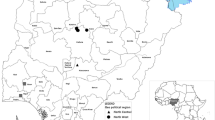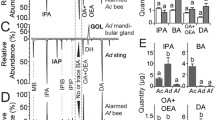Abstract
Of 12 alarm pheromones assayed in European and Africanized honeybees, nine were found in larger quantities in the Africanized population. Isopentyl and 2-heptanone levels were similar in both; 2-methylbutanol-1 was greater in European workers. These differences were not due to age or geographical location. Significant positive correlations between alarm pheromone levels and defensive behavior, especially numbers of stings, were observed.
Similar content being viewed by others
References
Blum, M.S., Fales, H.M., Tucker, K.W., andCollins, A.M. 1978. Chemistry of the sting apparatus of the worker honeybee.J. Apic Res. 17:218–221.
Blum, M.S., andFales, H.M. 1988. Chemical releasers of alarm behavior in the honey bee: informational ‘plethora’ of the sting apparatus signal,in Africanized Honey Bees and Mites. (G. Needham, R. Page, M. Delfinado-Baker, C. Bowman, (eds) pp. 141–148. Ellis Horwood Ltd., Chichester, England.
Boch, R., andRothenbuhler, W.C. 1974. Defensive behaviour and production of alarm pheromone in honeybees.J. Apic. Res. 13:217–221.
Boch, R., andShearer, D.A. 1966. Iso-pentyl acetate in stings of honeybees of different ages.J. Apic Res. 5:65–70.
Boch, R., andShearer, D.A. 1967. 2-Heptanone and 10-hydroxy-trans-dec-2-enoic acid in the mandibular glands of worker honey bees of different ages.Z. Vergl. Physiol. 54:1–11.
Boch, R., Shearer, D.A., andStone, B.C. 1962. Identification of iso-amyl acetate as an active component in the sting pheromone of the honey bee.Nature 195:1018–1020.
Collins, A.M., andBlum, M.S. 1982. Bioassay of compounds derived from the honeybee sting.J. Chem. Ecol. 8:463–470.
Collins, A.M., andBlum, M.S. 1983. Alarm responses caused by newly identified compounds derived from the honeybee sting.J. Chem. Ecol. 9:57–65.
Collins, A.M., andKubasek, K.J. 1982. Field test of honey bee (Hymenoptera: Apidae) colony defensive behavior.Ann. Entomol. Soc. Amer. 75:383–387.
Collins, A.M., Rinderer, T.E., Tucker, K.W., Sylvester, H.A., andLackett, J.J. 1980. A model of honeybee defensive behaviour.J. Apic. Res. 19:224–231.
Collins, A.M., Rinderer, T.E., Harbo, J.R., andBolten, A.B. 1982. Colony defense by Africanized and European honey bees.Science 218:72–74.
Collins, A.M., Rinderer, T.E., Harbo, J.R., andBrown, M.A. 1984. Heritabilities and correlations for several characters in the honey bee.J. Hered. 75:135–140.
Collins, A.M., Brown, M.A., Rinderer, T.E., Harbo, J.R., andTucker, K.W. 1987a. Heritabilities of honey-bee alarm pheromone production.J. Hered. 78:29–31.
Collins, A.M., Rinderer, T.E., Tucker, K.W., andPesante, D. 1987b. Response to alarm pheromone by European and Africanized honeybees.J. Apic. Res. 26:217–223.
Crewe, R.M., andHastings, H. 1976. Production of pheromones by workers ofApis mellifera adansonii.J. Apic. Res. 15:149–154.
Daly, H.V., Hoelmer, K., Norman, P., andAllen, T. 1982. Computer-assisted measurement and identification of honey bees (Hymenoptera: Apidae).Ann. Entomol. Soc. Am. 75:591–594.
Dobzhansky, T. 1970. Genetics of the Evolutionary Process, pp. 143–146. Columbia University Press, New York.
Falconer, D.S. 1981. Introduction to Quantitative Genetics, 2nd ed. p. 237. Longman Group Limited, London.
Kerr, W.E., Blum, M.S., Pisani, J.F., andStort, A.C. 1974. Correlation between amounts of 2-heptanone and iso-amyl acetate in honeybees and their aggressive behaviour.J. Apic. Res. 13:173–176.
Maschwitz, U. 1964. Alarm substances and alarming processes for danger in social Hymenoptera.Z. Vergl Physiol. 47:596–655.
Pickett, J.A., Williams, I.H., andMartin, A.P. 1982. (Z)-11-Eicosen-1-ol, an important new pheromonal component from the sting of the honeybee,Apis mellifera L. (Hymenoptera, Apidae).J. Chem. Ecol. 8:163–175.
Shearer, D.A., andBoch, R. 1965. 2-Heptanone in the mandibular gland secretion of the honeybee.Nature 205:530.
Snedecor, G.W., andCochran, W.C. 1967. Statistical Methods, 6th ed. p. 593. Iowa State University Press, Ames, Iowa.
Whiffler, L.A.,Drusedau, M.U.H.,Crewe, R.M., andHepburn, H.R. 1988. Defensive behaviour and the division of labour in the African honeybee (Apis mellifera scutellata).J. Comp. Physiol. A In press.
Author information
Authors and Affiliations
Rights and permissions
About this article
Cite this article
Collins, A.M., Rinderer, T.E., Daly, H.V. et al. Alarm pheromone production by two honeybee (Apis mellifera) types. J Chem Ecol 15, 1747–1756 (1989). https://doi.org/10.1007/BF01012262
Received:
Accepted:
Issue Date:
DOI: https://doi.org/10.1007/BF01012262




